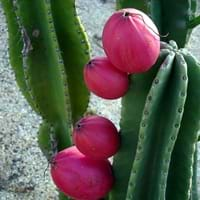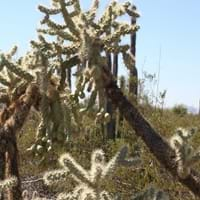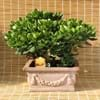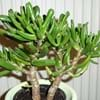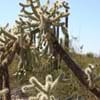Life Span
Annual
Not Available
Type
Cactus
Cactus or Succulent
Origin
South America, Argentina, Brazil
Southwestern United States, Mexico
Types
Not Available
Not Available
Habitat
Desert
Desert, Dry areas, Rocky areas
USDA Hardiness Zone
11-15
9-12
Sunset Zone
16, 17, 21, 22, 23, 24
10, 11, 12, 13, 18, 19, 20, 21, 22, 23
Habit
Upright/Erect
Upright/Erect
Flower Color
White, Yellow
Hot Pink, Rose, Bronze
Flower Color Modifier
Bicolor
Not Available
Fruit Color
Pink, Red
Green
Leaf Color in Spring
Green
Not Available
Leaf Color in Summer
Green
Not Available
Leaf Color in Fall
Green
Not Available
Leaf Color in Winter
Green
Not Available
Leaf Shape
Toothed
Not Available
Plant Season
Spring, Summer, Fall, Winter
Spring, Summer, Fall, Winter
Sunlight
Full Sun
Full Sun, Partial Sun
Type of Soil
Loam, Sand
Loam, Sand
The pH of Soil
Acidic, Neutral, Alkaline
Neutral, Alkaline
Soil Drainage
Well drained
Well drained
Bloom Time
Early Summer, Summer, Late Summer
Late Spring, Early Summer, Summer
Repeat Bloomer
No
Not Available
Tolerances
Drought, Salt
Drought
Where to Plant?
Container, Ground
Ground
How to Plant?
Seedlings
Leaf Cutting, Stem Cutting
Plant Maintenance
Medium
Medium
Watering Requirements
Never Over-water
Allow soil to be completely dry in between waterings
In Summer
Lots of watering
Lots of watering
In Spring
Moderate
Moderate
In Winter
Average Water
Average Water
Soil pH
Acidic, Neutral, Alkaline
Neutral, Alkaline
Soil Type
Loam, Sand
Loam, Sand
Soil Drainage Capacity
Well drained
Well drained
Sun Exposure
Full Sun
Full Sun, Partial Sun
Pruning
Remove damaged leaves, Remove dead branches, Remove dead leaves
Remove damaged leaves, Remove dead branches, Remove dead leaves
Fertilizers
All-Purpose Liquid Fertilizer
No fertilizers needed
Pests and Diseases
Red blotch
Red blotch, Root rot
Plant Tolerance
Drought
Drought, Dry Conditions, Heat Tolerance, Sun
Flower Petal Number
Double
Not Available
Fragrant Flower
Yes
Not Available
Fragrant Fruit
Yes
Not Available
Fragrant Leaf
No
Not Available
Fragrant Bark/Stem
No
Not Available
Foliage Texture
Bold
Bold
Foliage Sheen
Matte
Not Available
Attracts
Birds, Hummingbirds, Butterflies
Not Available
Allergy
Not Available
Not Available
Aesthetic Uses
Showy Purposes
Borders, Decorating walls
Beauty Benefits
Not Available
Not Available
Environmental Uses
Air purification
Air purification
Medicinal Uses
Antioxidants, Indigestion, Oedema, Wounds
Not Available
Part of Plant Used
Fruits
Stem
Other Uses
Showy Purposes
Not Available
Used As Indoor Plant
Yes
No
Used As Outdoor Plant
Yes
Yes
Garden Design
Container, Fruit, Fruit Tree, Hedges, Houseplant, Rock Garden, Wall, Tropical
Rock Garden, Wall
Botanical Name
CEREUS hildmannianus ssp. uruguayanus
CYLINDROPUNTIA fulgida
Common Name
Peruvian Apple Cactus
hanging chain cholla
In Hindi
Peruvian Apple cactus
jumping cholla
In German
Peruanische Apple-Kaktus
jumping cholla
In French
Péruvienne d'Apple Cactus
jumping cholla
In Spanish
Peruana de Apple Cactus
jumping cholla
In Greek
Του Περού μήλο κάκτος
jumping cholla
In Portuguese
Cactus a Apple peruana
jumping cholla
In Polish
Peruwiański Jabłko Cactus
jumping cholla
In Latin
Apple Peruviani Cactus
jumping cholla
Phylum
Magnoliophyta
Tracheophyta
Class
Magnoliopsida
Magnoliopsida
Order
Caryophyllidae
Caryophyllales
Family
Cactaceae
Cactaceae
Genus
Cereus
Cylindropuntia
Clade
Angiosperms, Core eudicots, Eudicots
Angiosperms, Core eudicots, Eudicots
Tribe
Cereeae
Not Available
Subfamily
Cactoideae
Not Available
Number of Species
Not Available
Not Available
Properties of Peruvian Apple Cactus and Jumping Cholla
Wondering what are the properties of Peruvian Apple Cactus and Jumping Cholla? We provide you with everything About Peruvian Apple Cactus and Jumping Cholla. Peruvian Apple Cactus has thorns and Jumping Cholla doesn't have thorns. Also Peruvian Apple Cactus does not have fragrant flowers. Peruvian Apple Cactus has allergic reactions like Not Available and Jumping Cholla has allergic reactions like Not Available. Compare all the properties and characteristics of these two plants. Find out which of these plant can be used as indoor plant. If you are interested to decorate your house and garden, find out aesthetic uses, compare them and select the plant which will beautify your surrounding. Along with beautification, try comparing medicinal and edible uses of Peruvian Apple Cactus and Jumping Cholla and you can choose the plant having best and most benefits.
Season and Care of Peruvian Apple Cactus and Jumping Cholla
Season and care of Peruvian Apple Cactus and Jumping Cholla is important to know. While considering everything about Peruvian Apple Cactus and Jumping Cholla Care, growing season is an essential factor. Peruvian Apple Cactus season is Spring, Summer, Fall and Winter and Jumping Cholla season is Spring, Summer, Fall and Winter. The type of soil for Peruvian Apple Cactus is Loam, Sand and for Jumping Cholla is Loam, Sand while the PH of soil for Peruvian Apple Cactus is Acidic, Neutral, Alkaline and for Jumping Cholla is Neutral, Alkaline.
Peruvian Apple Cactus and Jumping Cholla Physical Information
Peruvian Apple Cactus and Jumping Cholla physical information is very important for comparison. Peruvian Apple Cactus height is 300.00 cm and width 90.00 cm whereas Jumping Cholla height is 120.00 cm and width 90.00 cm. The color specification of Peruvian Apple Cactus and Jumping Cholla are as follows:
Peruvian Apple Cactus flower color: White and Yellow
Peruvian Apple Cactus leaf color: Green
Jumping Cholla flower color: Hot Pink, Rose and Bronze
- Jumping Cholla leaf color: Not Available
Care of Peruvian Apple Cactus and Jumping Cholla
Care of Peruvian Apple Cactus and Jumping Cholla include pruning, fertilizers, watering etc. Peruvian Apple Cactus pruning is done Remove damaged leaves, Remove dead branches and Remove dead leaves and Jumping Cholla pruning is done Remove damaged leaves, Remove dead branches and Remove dead leaves. In summer Peruvian Apple Cactus needs Lots of watering and in winter, it needs Average Water. Whereas, in summer Jumping Cholla needs Lots of watering and in winter, it needs Average Water.
